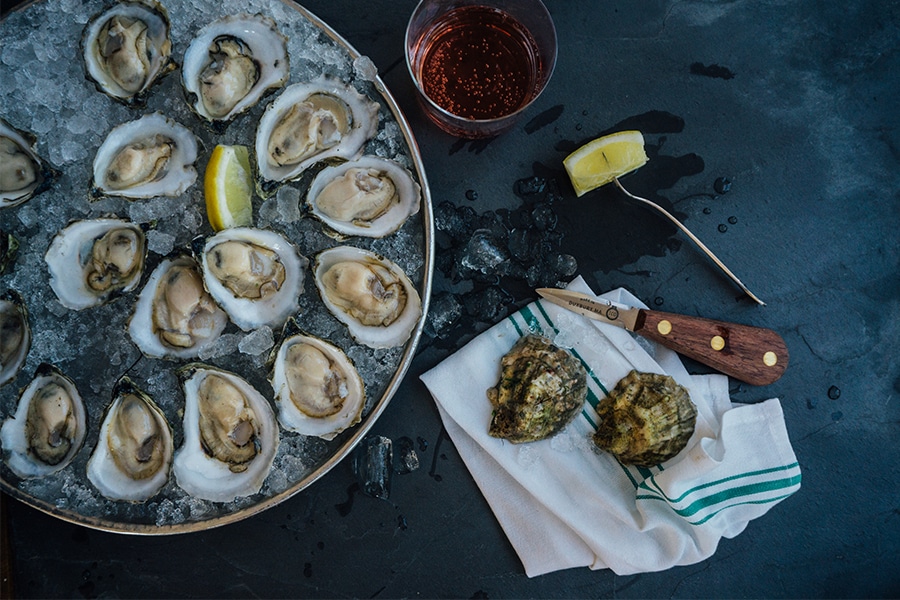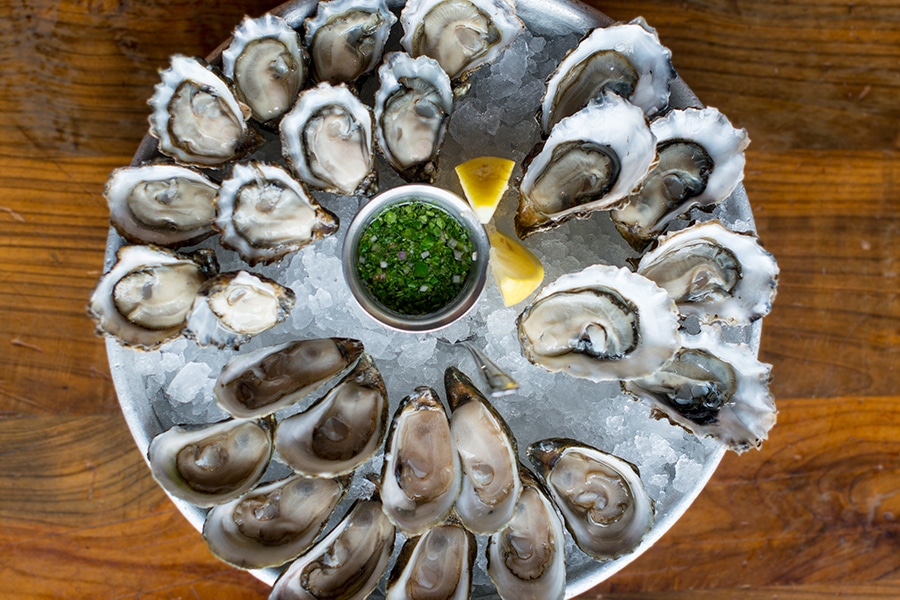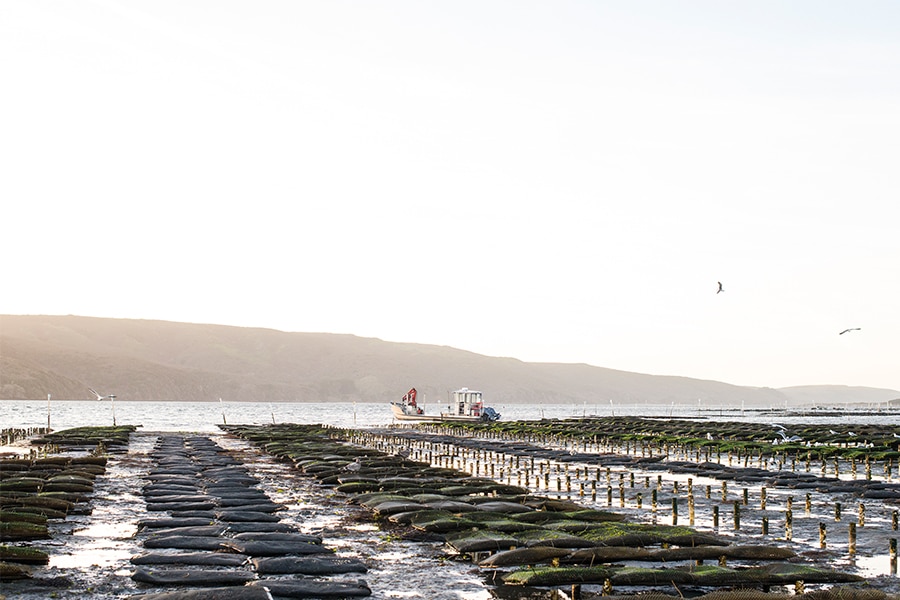The Ultimate Oyster Guide: How to Order, Eat, Shuck, and Store Oysters
Dive into our oyster guide to learn everything you need to know about ordering oysters in a restaurant and serving them at home.

Few things are as divine — or as intimidating — as a freshly shucked oyster. In the past 20 years, oysters have gone from an esoteric delicacy to a more commonplace menu item. Dedicated oyster farmers transformed aquaculture by creating their own branded oysters, frequently with quirky names, and oyster bars popped up all across the country. Gone are the days when it wasn’t safe to order oysters unless you were by the sea. Companies ship fresh oysters overnight, so even landlocked destinations can serve top-quality oysters from both coasts. However, this oyster explosion has made it more intimidating to dip your toe into the wide world of oysters. Our guide will answer all of your questions and give you the confidence to order a dozen fabulous oysters at your next dinner or to host an oyster party at home.
What are Oysters?
Oysters are a type of shellfish. Technically, they are bivalve mollusks, like clams and mussels, that grow in saltwater or brackish water. Oysters vary dramatically depending on their source. The meat can be soft, creamy, or firm. Some oysters are petite, with shells around 2 inches long, while others can be the size of your hand. The liquor — the briny liquid within the shell — can have high or low salinity. Oyster flavors range from sweet, creamy, nutty, smoky, metallic, to citrus and seaweed. Oysters are truly a product of their environment. Just like wine reflects its terroir, oysters showcase their “meroir.”
The Different Types of Oysters

North America has five types of oysters, but people frequently refer to them as East Coast or West Coast. While the East Coast has plenty of appellations and oysters from Virginia will taste different from oysters from Maine, they are all the same species: Crassostrea virginica. East Coast oysters have a salty, briny flavor with lots of minerality and firm flesh. They genuinely taste like the sea, which is why so many people love them. (And why some people can’t stand them.)
On the other hand, oysters from the West Coast can be from three different species: Pacific, Kumamoto, or Olympia. Pacific oysters — Crassostrea Gigas — are, in fact, the most common oyster found in the world. They are creamy, somewhat sweet, and less salty than East Coast oysters, making them an excellent choice for beginners. These oysters, native to Japan, quickly spread across the globe. In Europe, most oysters are actually Pacific oysters, despite names such as Irish Rock Oysters.
Another type of Japanese oysters, Kumamoto, is considered by many to be a delicacy. They are smaller, with a delicate brine and notes of honeydew. Olympia oysters are native to the West Coast, but they are challenging to grow, making them difficult to find. They are quite small and delicate. Today, they are farmed in Washington State.
European Flat oysters, also known as Belon oysters, are more uncommon. These enormous oysters have a robust metallic and smoky taste and are not for beginners. (I have eaten thousands of oysters, but only one Belon. They are not for me.) Some growers in Maine farm Belon oysters, and you can find them in Europe, too.
How to Order Oysters in a Restaurant or an Oyster Bar
Oyster bars are fantastic places to discover new oysters, compare different flavors, and discover your favorite kind. But it’s easy to go overboard and end up a bit lost by ordering too many different types of oysters. One of the best things about eating at an oyster bar is that you can order several courses of oysters to avoid being overwhelmed.
Beginners should ask their waiter for recommendations of more approachable oysters. Start by ordering four different kinds of oysters — two East Coast and two West Coast. When the oysters arrive, the waiter should identify each kind to you. Sometimes, the waiter will give you a receipt or a list of the oysters so you can keep track of which is which.
Try the oysters by alternating East and West to see if you prefer the salinity and minerality of East Coast oysters or prefer West Coast oysters’ creamy sweetness. Once you have determined your preference, order a second round. Now, order four different oysters from the same region. Be sure to order two of each kind — taste one of each kind, comparing the different flavors and nuances. After you’ve tried them all, go back to the remaining oysters and eat them in order of your least favorite to favorite, ending with your preferred oyster, of course!
Ostreophiles — the fancy word for oyster lovers — can embrace the full scope of the menu. I’ll typically order 12-18 oysters for myself. I always order two of each kind to come back and compare after I have tasted them all. This way, I can come back to compare two oysters I found to be similar and appreciate their distinguishing nuances.
Restaurants tend to have smaller oyster selections than oyster bars. Typically, you’ll find one kind of oyster or an East and a West Coast option. A good rule of thumb is to order three oysters per person as an appetizer or six per person if the group loves oysters.
How to Eat Oysters
If you’re eating oysters in a restaurant, you’ll eat oysters on the half shell. To eat the oyster directly from the shell, tip the oyster back into your mouth to savor the liquor — the liquid within the shell. Then, lightly chew the oyster to release even more flavor. After you’ve eaten the oyster, place it back in the tray in the same spot. Be sure to place the shell facing down to know how many oysters are left to eat. If you don’t want to slurp the oyster directly from the shell, you can use a cocktail fork to pick up the oyster.
A restaurant will typically serve oysters accompanied by lemon, mignonette, hot sauce, or cocktail sauce. But eating an oyster “naked” — without anything — is the best way to experience its terroir and full flavors. It can be quite a briny experience. A couple of drops of lemon or mignonette can cut the saltiness and enhance the flavor. Just don’t put on too much, or you won’t be able to taste the oyster. I find cocktail sauce to be too overpowering for oysters’ delicate flavor.
How to Store Oysters at Home
It is imperative to keep oysters cold. When you receive your oysters, put them in a bowl cupside down. Cover the bowl with a damp cloth and place the bowl in a cold part of your fridge. Do not add water to the bowl — it will kill them. If you store oysters this way, they can stay fresh for up to seven days.
How to Tell if Oysters Are Good
Fresh oysters will have tightly closed shells. Once you open the shell, there will be liquid — called liquor — inside. If an oyster is dried out, it’s not good, and you should discard it. Fresh oysters will smell like the sea, but not fishy. If your oysters smell like sulfur or rotten eggs, throw them out immediately. I sniff each oyster I shuck to ensure they pass the smell test.
How Do You Shuck Oysters at Home?
Opening oysters is called shucking. While it might seem intimidating, it’s pretty easy to do. The most important thing you need to have is the right knife. Without a proper knife, you’ll have a hard time shucking. Unfortunately, many so-called oyster knives are difficult to use. Our pick is R. Murphy Knives’s shucking knife, which has the perfect blade. Island Creek Oysters, one of our favorite oyster companies, also recommends it.
First, place the oyster on a flat surface, like a cutting board. Next, place your non-dominant hand on top of the broad side of the oyster. Then, take your knife, hold it at a 45-degree angle, and put it into the hinge of the oyster. As you apply pressure, wiggle the blade back and forth into the hinge. Be careful not to use too much pressure — you don’t want to risk losing control and having the knife go flying — but you do need some force to open the shell.
Once the knife slips into the hinge, turn the knife to pop open the shell. Take out the blade and wipe it clean on a towel. Then slide the knife down the length of the oyster to cut the top adductor muscle. Be sure to keep the knife as high as possible, so you don’t slice through the oyster meat itself. After you cut the muscle, you can discard the top shell. Now, take a look at the oyster and be sure there are no bits of shell in it. You can remove these with the tip of your knife or a paper towel. Finally, run your knife beneath the side of the oyster to cut the bottom muscle so you can tip the oysters back easily. Eat the oyster straight away, or nestle it in a plate of crushed ice.
The Best Places to Buy Oysters Online
Today, there are tons of places to buy oysters online. These oysters will be shipped overnight and arrive fresh on your doorstep the next day. Ordering from different parts of the country is a fantastic way to explore the different terroirs and discover new oysters. Some of our favorite places are Island Creek Oysters, Pangea Shellfish, Fulton Fish Market, Goldbelly, and Hog Island Oyster Co.
Oysters, Sustainability, and the Environment

After decades of overfishing, wild oyster stocks have been decimated. But in recent decades, oyster farms have popped up all along the coasts. Unlike other types of seafood, farmed oysters are excellent for the environment. Oysters are filter feeders, which means they clean the surrounding water. Oyster reefs also provide habitats and food for other marine life, as well as protecting nearby land. According to the Billion Oyster Project, a non-profit organization in New York City dedicated to restoring oyster reefs in New York Harbor, oyster reefs can minimize the impact of large waves, reduce flooding, and prevent erosion. So, you can eat up knowing that your oysters are sustainably grown and positively impact the environment.
Wine Pairings for Oysters
Oysters have a delicate flavor that can be easily overwhelmed, which is why lighter white wines are a perfect pairing. Champagne, Chablis, Gruner Veltliner, and Albarino are all excellent wines to serve with oysters. Beer is also a popular choice. Again, pick a lighter, more delicate beer that won’t overwhelm the flavors of the oysters. Gueze, a Belgian beer, is a popular choice among experts.
The Best Books About Oysters
Rowan Jacobsen wrote two excellent books about oysters. His first, A Geography of Oysters, was my introduction to the wonderful world of oysters. He makes the topic of oysters accessible and is wickedly funny. His second book, The Essential Oyster, is also excellent. If you’re more interested in history, check out The Big Oyster by Mark Kurlansky.
Are Oysters Alive?

Technically, if you are eating raw oysters on the half shell, yes, they are alive. However, oysters don’t feel any pain — they don’t have a brain or a central nervous system. Because of this, many vegans will eat oysters. In addition, oysters become dormant at 40 degrees, which is how they are stored, served, and eaten. This means that in the improbable event that they could feel pain, they wouldn’t at this temperature.


